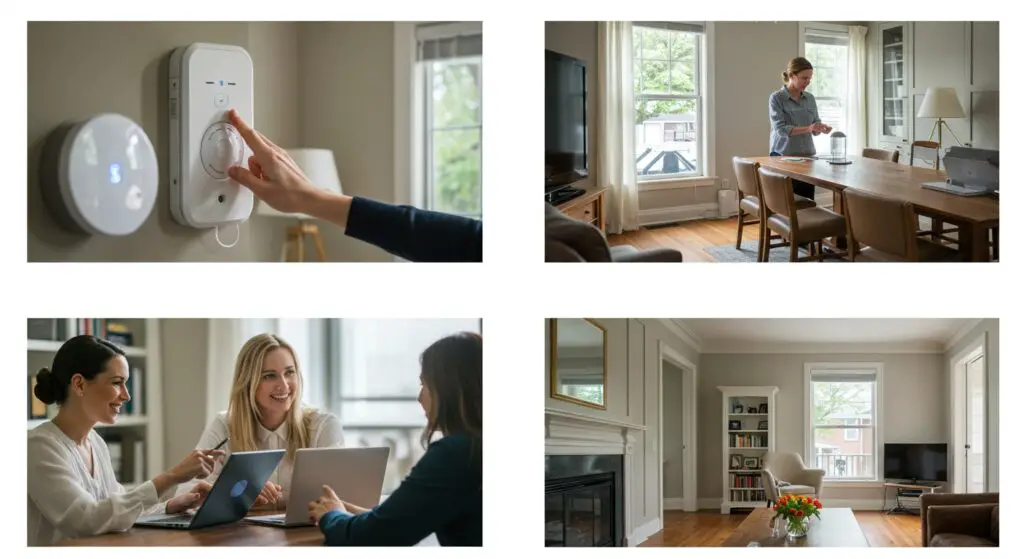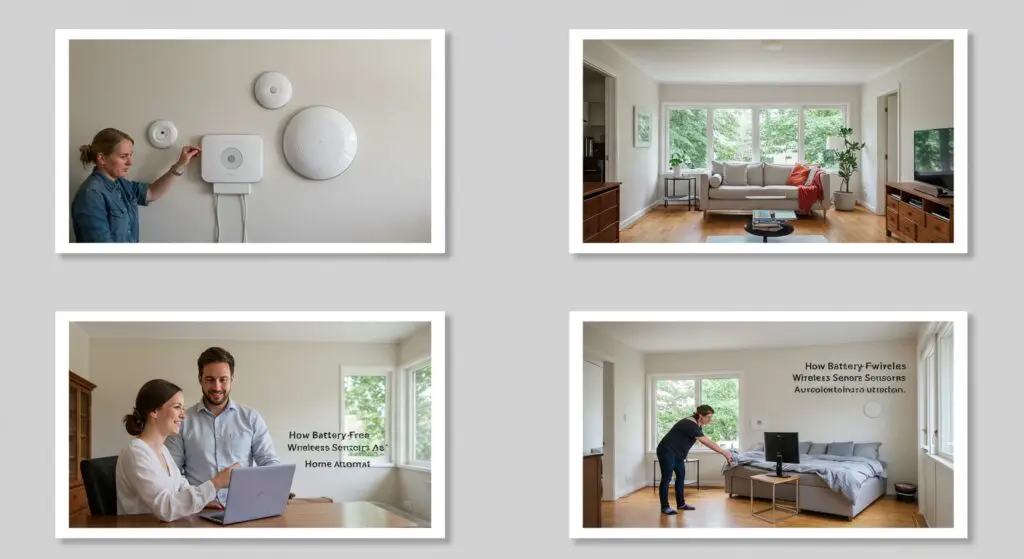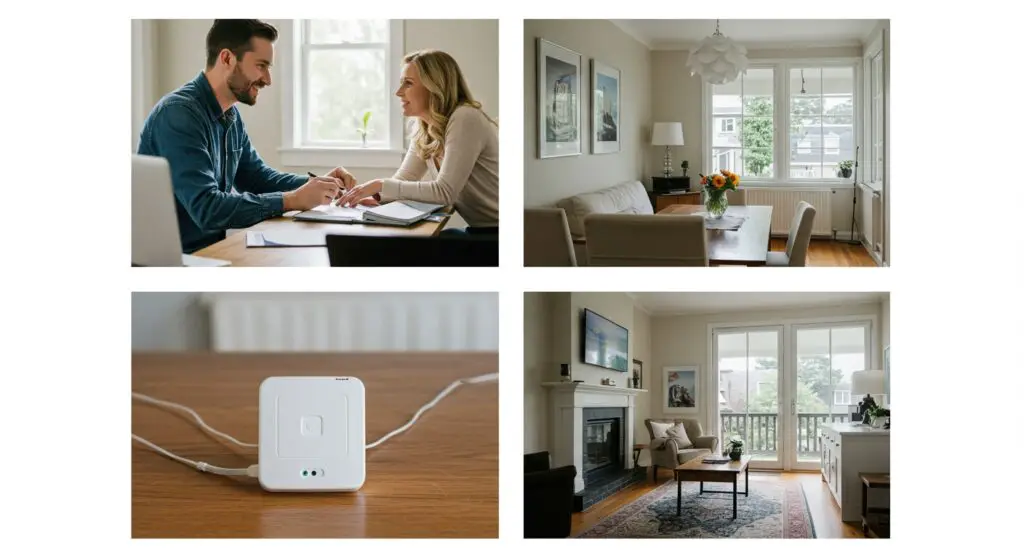Imagine a home where your smart devices never run out of power. Forget the constant hassle of replacing batteries. Envision a truly autonomous living space. This seemingly futuristic concept is now a tangible reality. Battery-free sensors home automation is rapidly transforming how we interact with our intelligent environments. This innovative technology is ushering in an era of unparalleled convenience and sustainability. It marks a significant leap forward for smart home technology.

Traditional smart home sensors rely on disposable batteries. These batteries need frequent replacement. This creates a hidden burden of maintenance and environmental waste. However, a new wave of devices is emerging. These are wireless sensors without batteries smart home. They harvest energy from their surroundings. This eliminates the need for external power sources. This shift is not merely an incremental improvement. It is a fundamental revolution in home automation sensors. It promises a future of truly self-sufficient smart homes.
The Dawn of True Autonomy: Why Battery-Free?
For years, smart home enthusiasts have embraced the convenience of automated systems. Yet, a persistent challenge lingered. The reliance on batteries presented a significant Achilles’ heel. Every motion sensor, every door contact, every temperature monitor eventually required a power refresh. This ongoing task was tedious and often led to system downtime. It hindered the dream of a truly set-and-forget smart home. This is where battery-free technology steps in.
The Persistent Pain Points of Traditional Sensors
Conventional smart home sensors come with several inherent drawbacks. First, battery depletion causes system failure. A dead sensor means a blind spot in your security or an inaccurate temperature reading. Second, the environmental impact of discarded batteries is substantial. Millions of batteries end up in landfills each year. This contributes to pollution. Third, the cost of replacement batteries adds up over time. This makes the total cost of ownership higher than initially perceived. These factors collectively highlight the limitations of battery-dependent systems.
Moreover, certain installations become problematic with batteries. Sensors placed in hard-to-reach areas are difficult to maintain. Think about a smart window sensor on a high skylight. Replacing its battery becomes a chore. This reduces the practical appeal of smart solutions in diverse architectural settings. The need for constant vigilance over battery levels also detracts from the seamless experience smart homes promise. This makes maintenance-free smart home sensors a highly desirable solution.
A Paradigm Shift: The Promise of Self-Sufficiency
The advent of battery-free sensors home automation signals a profound shift. It moves from reactive maintenance to proactive self-sustainability. These devices operate by harnessing ambient energy. This includes light, motion, heat, or radio frequency waves. They convert this energy into electricity. This powers their operations and communication. This innovative approach promises a future free from battery-related woes. It ensures continuous, uninterrupted performance. This is the core advantage of self-powered smart home sensors.
This new paradigm offers immense advantages. It eliminates recurring costs and environmental waste. It also enhances system reliability. Imagine your smart home security sensors always active. Your climate control always responsive. Your lighting always intelligent. All without ever thinking about a battery change. This is the promise of sustainable smart home sensors. They truly revolutionize the user experience. They enable a more seamless and truly autonomous living environment.
Unpacking the Technology: How Do Battery-Free Sensors Work?

The magic behind battery-free technology lies in energy harvesting. These innovative sensors do not require a direct electrical connection or an internal battery. Instead, they capture minute amounts of energy from their surroundings. This energy is then converted into usable power. This allows the sensor to perform its function and transmit data. Understanding these mechanisms reveals the ingenuity of no battery smart home devices.
Energy Harvesting: The Core Principle
Energy harvesting is the process of deriving electrical energy from external sources. These sources are often ambient. They include solar power, thermal energy, kinetic energy, and radio frequency energy. Each method has specific applications and efficiencies. The choice of harvesting method depends on the sensor’s intended use and environment. This diverse approach makes battery-free technology highly versatile.
Photovoltaic (Light) Energy
Photovoltaic cells, or solar cells, are a common form of energy harvesting. They convert light energy directly into electrical energy. Even indoor ambient light can provide enough power for low-power sensors. These sensors are ideal for well-lit areas. They are highly efficient for continuous operation. This makes them perfect for smart home applications like light sensors or environmental monitors.
Thermoelectric (Heat) Energy
Thermoelectric generators (TEGs) convert temperature differences into electrical voltage. This is known as the Seebeck effect. For instance, a TEG could harvest energy from the temperature differential between a warm pipe and the cooler ambient air. This allows sensors to be powered by heat fluctuations. This is particularly useful in HVAC systems or industrial monitoring within a smart home context.
Piezoelectric (Kinetic) Energy
Piezoelectric materials generate an electrical charge when subjected to mechanical stress or vibration. Imagine a sensor embedded in a floor tile. It could generate power every time someone steps on it. Or a sensor attached to a door hinge. It could generate power with every opening and closing. This kinetic energy harvesting is excellent for motion-activated or event-driven sensors. It provides bursts of power for specific actions.
Radio Frequency (RF) Energy
RF energy harvesting captures ambient radio waves, such as those from Wi-Fi signals or dedicated RF transmitters. These waves carry energy that can be converted into electricity. This method allows for truly passive wireless sensors smart home. They can be powered entirely by existing wireless infrastructure. This is revolutionary for devices that need to be placed in areas with no direct light or significant temperature differentials.
Communication Protocols and Efficiency
Once energy is harvested, the sensor needs to communicate its data. Battery-free sensors often use ultra-low-power wireless communication protocols. These include Bluetooth Low Energy (BLE), Zigbee, or proprietary protocols optimized for minimal power consumption. The design prioritizes efficiency. Sensors send small data packets intermittently. This conserves the harvested energy. This ensures reliable transmission even with limited power. This is how battery-free sensors work home automation effectively.
These systems also incorporate tiny energy storage components. These are often supercapacitors, not traditional batteries. Supercapacitors charge rapidly and discharge slowly. They bridge gaps in energy availability. This allows sensors to operate consistently. This robust design underpins the reliability of wireless sensor networks home automation. It ensures a seamless flow of data within your smart environment.
The Multifaceted Benefits of Battery-Less Home Sensors
The transition to battery-less home sensors offers a cascade of advantages. These benefits extend beyond mere convenience. They touch upon sustainability, cost-efficiency, and overall system reliability. Embracing this smart home battery-free technology means investing in a more intelligent and responsible future. The advantages of self-powered home sensors are compelling and transformative for modern living.
Unprecedented Convenience and Zero Maintenance
Perhaps the most immediate and appealing benefit is the eradication of battery maintenance. Homeowners no longer need to track battery levels or perform routine replacements. This saves significant time and effort. It eliminates the frustration of discovering a dead sensor just when you need it most. This truly delivers on the promise of a maintenance-free smart home. Devices simply work, day in and day out, without intervention.
Enhanced Sustainability and Eco-Friendliness
Battery production and disposal carry a substantial environmental footprint. By eliminating the need for disposable batteries, battery-free sensors significantly reduce waste. They minimize the consumption of finite resources. This aligns perfectly with growing environmental consciousness. These eco-friendly home automation sensors contribute to a greener, more sustainable lifestyle. They reduce your household’s carbon footprint.
Superior Reliability and Longevity
Traditional batteries degrade over time. Their performance diminishes, and they eventually fail. Battery-free sensors, however, are designed for extreme longevity. They have no chemical components that degrade. Their lifespan is often limited only by the durability of their physical components. This leads to more reliable and consistent performance. It reduces the likelihood of unexpected system failures. This inherent resilience makes them ideal for critical applications like battery-free smart home security sensors.
Scalability and Cost-Effectiveness Over Time
While the initial cost of battery-free sensors might sometimes be slightly higher, the long-term savings are substantial. Eliminating battery purchases adds up. Reducing maintenance labor costs provides further savings. This makes the overall total cost of ownership lower over the product’s lifespan. Furthermore, the ease of deployment without worrying about power outlets or battery access enhances scalability. You can add more sensors effortlessly. This makes expanding your smart home ecosystem more straightforward and economical.
Diverse Applications: Types of Battery-Free Smart Home Sensors

The versatility of energy harvesting technology means battery-free sensors can fulfill a wide array of roles within the smart home. From ensuring comfort to bolstering security, these devices are revolutionizing home automation sensors across various domains. The types of battery-free smart home sensors are continually expanding. They offer innovative solutions for almost every aspect of modern living.
Environmental Monitoring (Temperature, Humidity, Air Quality)
Battery-free temperature and humidity sensors can be placed virtually anywhere. They provide precise climate control without power concerns. Imagine monitoring the temperature in a remote attic or a rarely used basement. These sensors deliver continuous data. Similarly, self-powered air quality sensors can detect pollutants. They ensure a healthy indoor environment. They trigger ventilation systems when needed. This constant, reliable monitoring is crucial for comfort and well-being.
Security and Access Control (Motion, Door/Window, Presence)
Battery-free smart home security sensors are a game-changer. Kinetic energy sensors on doors and windows can detect openings and closings. They send alerts without needing batteries. Passive infrared (PIR) motion sensors powered by ambient light or RF energy can monitor activity. They enhance security perimeters. These systems provide robust, always-on protection. They eliminate the weakest link of battery dependency in crucial security applications. This ensures your home remains secure and monitored around the clock.
Appliance and Energy Management
Energy harvesting sensors can monitor appliance usage. They track power consumption without needing an external power source. For example, a current sensor around a power cable could harvest energy from the magnetic field. This would allow it to report appliance status. This provides valuable insights into energy efficiency. It helps homeowners manage their energy consumption more effectively. This contributes to a truly sustainable smart home.
Health and Wellness Monitoring
Beyond traditional smart home functions, battery-free sensors are also finding applications in health and wellness. Wearable sensors, for instance, could harvest kinetic energy from movement. They would monitor vital signs without needing to be charged. In a home setting, pressure sensors in beds or chairs could monitor occupancy. They could provide discreet alerts for elderly care. These innovations offer new levels of passive monitoring and support.
Integrating Battery-Free Wireless Sensors into Your Smart Home
Adopting battery-free wireless sensors for smart home integration is a forward-thinking step. While the technology offers unparalleled benefits, a thoughtful approach to installation and compatibility ensures optimal performance. Understanding how to incorporate these innovative devices into your existing or new smart home ecosystem is key. Installing battery-free wireless sensors effectively maximizes their potential.
Planning Your Battery-Free Ecosystem
Start by identifying areas where battery-free sensors would provide the most value. Consider locations that are difficult to access. Think about areas with consistent environmental energy sources. For instance, a light-powered sensor works well near windows. A kinetic sensor is ideal on high-traffic doors. A thermoelectric sensor thrives near heating vents. A comprehensive plan ensures you leverage the strengths of each energy harvesting method. This optimizes your smart home setup.
Consider the specific data you need. Do you require frequent updates or occasional status checks? This influences the type of sensor and its energy harvesting requirements. For example, a security sensor might need immediate, reliable communication. An environmental sensor might send data less frequently. Proper planning leads to an efficient and robust wireless sensor network home automation solution.
Installation Considerations for Optimal Performance
Installing battery-free wireless sensors often involves simple placement. However, consider the ambient energy source. For light-powered sensors, ensure they receive adequate illumination. For kinetic sensors, place them where mechanical action is consistent. RF-powered sensors need to be within range of an RF transmitter. Always follow manufacturer guidelines for optimal placement. This ensures consistent energy harvesting and reliable operation.
Ensure the mounting surface is appropriate. Many sensors are small and adhesive-backed. Some might require screws. Proper installation guarantees the sensor remains stable. It also ensures it can effectively harvest energy. This attention to detail during installation maximizes the advantages of self-powered home sensors. It contributes to a truly maintenance-free smart home experience.
Compatibility with Existing Smart Home Hubs
Most battery-free sensors communicate using standard wireless protocols. These include Zigbee, Z-Wave, or Bluetooth Low Energy (BLE). This often allows for seamless integration with existing smart home hubs. Check your hub’s compatibility. Many modern hubs support multiple protocols. Some manufacturers offer dedicated bridges for their battery-free ecosystems. This ensures your new devices can communicate effectively with your current smart home setup. Powering wireless sensors home automation relies on robust connectivity.
Look for devices that are part of open standards or widely supported platforms. This enhances interoperability. It future-proofs your investment. A well-integrated system means all your smart home devices, battery-free or otherwise, work in harmony. This creates a cohesive and intelligent living environment. This ensures your smart home battery-free technology functions as a unified whole.
The Future Landscape: What’s Next for Home Automation Sensors?

The journey of battery-free sensors home automation is just beginning. As technology continues to advance, we can expect even more sophisticated and ubiquitous applications. The future of home automation sensors points towards even greater autonomy, efficiency, and integration. This ongoing evolution promises to redefine our living spaces.
Miniaturization and Enhanced Efficiency
Researchers are continuously developing smaller, more efficient energy harvesting components. This will lead to even tinier, less obtrusive sensors. Imagine sensors seamlessly integrated into wallpaper, furniture, or even clothing. Improved efficiency means these devices will require even less ambient energy to operate. This expands their deployment possibilities. This miniaturization will make smart technology truly invisible, blending seamlessly into our environments.
Broader Adoption and Standardization
As the benefits become more widely recognized, battery-free technology will see broader adoption. We can expect more manufacturers to embrace these solutions. Increased demand will drive down costs. This will make them accessible to a wider consumer base. Standardization efforts will also improve interoperability. This will simplify the process of installing battery-free wireless sensors. It will foster a more unified smart home ecosystem across different brands and platforms.
The Truly Autonomous, Self-Sustaining Home
Ultimately, the future envisions a home that is truly self-sustaining. A comprehensive network of energy harvesting sensors will monitor every aspect of the environment. These sensors will communicate seamlessly. They will optimize energy consumption, enhance security, and personalize comfort. This vision of a self-powered smart home is no longer science fiction. It is a rapidly approaching reality. It promises unprecedented levels of convenience, sustainability, and intelligent living.
This revolutionizing home automation sensors marks a pivotal moment. It moves us towards homes that not only respond to our needs but also sustain themselves. The benefits of battery-less home sensors are clear. They represent a significant step towards a more intelligent, efficient, and environmentally responsible future. The era of the truly autonomous home is upon us, powered by innovation and a commitment to sustainability.